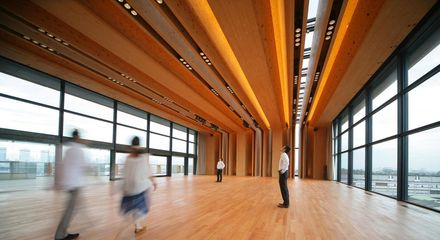ARCHITECTS
Nikken Sekkei
MAIN CONTRACTOR
Taisei Corporation
LIGHTING DESIGN
Hideto Mori(LightingM)
MECHANICAL & ELECTRICAL ENGINEER
NIKKEN SEKKEI, Koji Sugihara, Koichiro Hara
QUANTITY SURVEYOR
Nikken Sekkei
MAIN CONTRACTOR
Taisei Corporation
INTERIOR WORKS
NIKKEN SEKKEI, Tomohiko Yamanashi, Takeyuki Katsuya
CIVIL ENGINEER
NIKKEN SEKKEI, Toshihiko Kouno, Takeshi Asakawa, Seiya kimura
STRUCTURAL ENGINEER
NIKKEN SEKKEI, Toshihiko Kouno, Takeshi Asakawa, Seiya kimura
LOCATION
Koto, Japan
CATEGORY
Institutional Buildings, Office Buildings
Text description provided by architect.
This project involved the relocation of the offices of the Association of Wood Wholesalers in Tokyo. It serves as a showcase to demonstrate the possibilities of wood as an urban construction material.
Engawa, or Japanese terraces, allow a natural breeze to enter while shutting out strong sunlight for a comfortable indoor environment. Lumber were integrated into the building's structure, and architectural exposed concrete was cast in cedar formwork.
Since the building uses a large amount of wood, great attention was given to fire safety measures. The design focused on creating spatial continuity with the use of layering and natural light.
SPACE CONFIGURATION
A semi-outdoor space called engawa, existing in traditional Japanese homes, allows a natural breeze to enter the shelter while shutting out strong sunlight, achieving a comfortable indoor environment in the midst of harsh heat and humidity.
From the traditional engawa, a new space configuration was realized. In this configuration, elements of an office, such as its structure, circulation system, and facilities, are reconstructed in a semi-outdoor environment.
This configuration strives to connect the outdoors with the universal office, while simultaneously acting as a buffer against the harsh side of the external environment. Sets of terraces come together to make a porous skin.
Deep eaves shut out direct sunlight and rain as well as offer a comfortable outdoor area where one can experience natural light, breezes, and other aspects of nature, as if living in the middle of the woods.
WOOD CULTURE
There has been an architectural culture since ancient Japan, where the structure is made up of lines of beams and columns. This building aims to revive such a culture in an urbanized area in a newly developed form.
In order to feel the presence and texture of wood using all five senses, 105mm x 105mm blocks of wood, a standard size distributed by the timber markets of Japan, were stacked or integrated into all parts of the building.
In order for the SRC (Steel Reinforced Concrete), the structural support of this architecture, to merge with the scale of wood, the width of the plate-like pillars were kept to a minimum and the concrete was given a wooden texture by casting it in cedar frames.
TECHNICAL METHOD
This building utilized Numerical Control Machining (otherwise known as NC), an innovative wood cutting machine. Processing wood often relies a great deal on craftsmanship. However, the NC method achieves high accuracy and productivity and is able to create highly abstract designs.
The hall on the top floor was assembled from 115mm beams of wood that were processed by NC to form a structural body that spans about 25m. A traditional Japanese technique was modified to adjoin the wooden beams along their lengths to establish one combined panel.
Oak wooden plugs were inserted in between the cypress and were unified by bolts, creating a new smooth surface to wood, which is only possible with the high accuracy of the NC method.
FIRE PREVENTION
One complication faced when using wood in architecture is fire safety. This building overrides this issue by providing adequate ceiling height to accumulate fire smoke and made use of wood in many parts of the building possible.
PASS THROUGH AND OVERLAP
There is an aspect of Japanese spatial composition that makes use of layering and preserves spatial continuity. Instead of building a wall to divide spaces, fixtures are installed to give an abstracted impression of the adjacent space.
In this way, spaces flow from one into other. This building achieves this spatial richness.
Rooms, walls, and the roof are dispersedly located, giving movement and flow to the scene, while a sense of the next space is subtly delivered, via the sights that pass through or the light that enters into an area.






































